Author: Tosh Lubek Published: 11th August 2023
DIY Video Studio is supported by its readers who use the affiliate links or ads on this site. As an Amazon Associate, I earn from qualifying purchases. Thank your support if you use any of the links.
The Helios-44M is part of the Helios-44 series of lenses, all of which use derivatives of the Carl Zeiss Biotar optical formula, which is renowned for the “swirly” bokeh it can produce.
As you would expect, point-like sources of light form circular bokeh balls when thrown out of focus, but on the Helios-44 series of lenses the bokeh balls become increasingly elliptical the further they are from the center of the image.
The 44M, like the other lenses in the series, also produces sharp images at the center of the frame but the sharpness gives way to a softer image towards the edges. You can see this clearly in this photo of a brick wall, shot at f2.

The swirly bokeh and edge softness gives these lenses their distinct character, which has become sought after by many fine art photographers and videographers.
The Helios 44M was produced in huge numbers, being in production from the mid-1970s until the mid-1980s. They were made in the Soviet Union (USSR) at the KMZ, BelOMO, and Valdai plants. The commonly available 44M lenses made by KMZ and BelOMO are worth getting. Those made by Valdai are not as good and frequently will have oily aperture blades.
But in general, the Helios-44M is very well built, quite solid, and weighs in at 290g, this is somewhat more than its predecessor, the Helios 44-2. There were even some multicoated (MC) versions of the 44M, although these are somewhat uncommon.
Because Helios 44M lenses were made in huge numbers, you will find them easily available online and at low prices.
BUYING TIP: These lenses were effectively a kit lens for Zenit cameras. You can often get a better deal buying the lens along with the camera than just buying the lens. This is probably because there are fewer buyers of Zenit cameras than just the kit lens.
Helios 44M technical details
The Helios 44M is a prime lens with a focal length of 58mm, a maximum aperture of f2, and a minimum aperture of f16.
The Helios 44M has 8 aperture blades, so it will produce sunbursts or starbursts with eight spikes. As you turn the aperture ring there is a noticeable click. Between f2 and f11, each click represents a change of half a stop. But there is just one click as you go between f11 and f16.

It has a standard M42 mount, so it can easily be adapted onto DSLRs and mirrorless cameras.
The focus ring turns smoothly, but it has a very long throw of about 250° as you go from the minimum focus distance of 0.55m (22 inches) to infinity. If you’re going to use this lens
Occasionally you might encounter a Helios-44M where the focus ring can be stiff, or the movement might be uneven. This is due to the age of the grease on the helical focusing thread and easily remedied. The lens can easily be disassembled, the old grease cleaned off, and new grease applied.
You can use modern filters on the Helios 44M without any issues since it has a 52mm front filter thread.
Helios-44M manual and auto switch
Apart from the exterior appearance, one of the differences between the Helios 44-2 and the Helios 44M is that the latter has a silver dial switch near the base of the lens barrel. It can be set to M (manual) or A (auto).

This switch represents a major Helios 44M innovation, it’s the Automatic Aperture Control that worked with compatible Zenit cameras, such as the Zenit-E.
When in manual mode the aperture blades move as you turn the aperture. But in automatic mode, the aperture blades remain wide open as you turn the aperture ring, allowing the image in the viewfinder to be bright, irrespective of the chosen aperture.
The aperture blades would only shut down to the preselected value when the camera’s shutter was pressed. This was done by the camera pushing the pin on the base of the lens when the shutter button was pressed.

Generally, the automatic aperture control switch should be set to M when the lens is used on modern digital cameras. However, if the face of your lens adapter pushes the pin into the lens, it does not matter whether the switch is set to M or A since the aperture blades will always move as you turn the aperture ring.
Why get the Helios 44M instead of the Helios 44-2
If all you are interested in is maximizing the swirly bokeh, then the Helios 44-2 is slightly better than the 44M, but there isn’t much in it. If you are new to this lens series, you probably won’t notice any difference. So, if the images will be almost the same, why would you consider getting the 44M over the 44-2?
First, most of the Helios 44M copies seem to be in better shape than those of the 44-2. When I got my Helios 44M off eBay you’d almost think it was old new stock. The lens barrel was clean with no marks, and the black paint wasn’t worn through to the metal in frequently touched places. The paint on the numbers of the focus, depth of field, and aperture scales still looked fresh, and the optics looked great. The aperture and focus rings turned smoothly, with no oil on the aperture blades.
This isn’t so unusual. I’ve heard others mention that their copy of this lens doesn’t look its age. The main problem seems to be the grease on the helical focuser drying out with age and needing to be refreshed.
Next, in my opinion, the Helios 44M is a prettier lens when adapted onto a modern mirrorless camera. It doesn’t look out of place and is like some weird addition on the front of the camera body.

The third reason to get the 44M is because the aperture control is more like that of a modern manual lens, and therefore more familiar. The Helios 44-2 has a strange arrangement where you need to use two rings to set the aperture.
Fourthly, the Helios 44M seems to have a better build quality. Some 44-2 lenses have a loose mounting flange and can be prone to oil on the aperture blades (especially those made at the Valdai plant). Generally, the 44M does not have these issues.
The fifth reason is that a good example of the Helios 44M will cost less than an average Helios 44-2. This is presumably because some people don’t realize that the Helios 44-2 and 44M both have the same lens formula. They both produce swirly bokeh and the 44M is sharper in the center of the frame. Whatever the reason, the Helios 44M can be bought for less than a Helios 44-2.
The sixth and final reason is the robust design and build of the 44M. It’s heavier than the 44-2 because of the extra use of brass and steel metal. Coupled with the fact that it does not suffer many mechanical problems, I’d not be surprised if my lens is still being used in another forty or fifty years.
Sample Video SHot with the Helios 44M on a Canon EOS R6
Conclusion
I like the Helios 44M lens. It’s solid and the build quality is very good compared to Helios 44-2.
I believe the main three materials used in the lens are steel, brass, and glass (ignoring the paint for the black body and colored dials). With this lens built like a tank, there’s little to go wrong. If you do need to clean the optics or regrease the moving components this is an easy DIY job that almost anyone can do.
Because of the quantity made, and a seeming preference for the Helios 44-2 among photographers and videographers, the Helios 44M is easy to find at a very cheap price.
Although the 44M produced slightly less swirly bokeh than the 44-2, there’s not much in it, and the 44M is sharper in the center. Coupled with its ridiculously low price and the ease of getting a good copy, that’s why I think the Helios 44M is a bit of a gem.
You might also like…
Here’s a big ask from me: If you liked this article, please share it.
It will mean a great deal to me if you share this post because a few seconds of your time will seriously help my blog grow. The share buttons are below the “About Author” section.
Thanks. 🙂
About the author: Tosh Lubek is a multi-award-winning broadcaster, writer, and video producer, with 40 years of experience in professional broadcasting and has been using Canon video and stills cameras since 2010. He has worked with radio and TV broadcasters, advertising agencies, and direct clients on a variety of projects including radio and television advertising, online video production, corporate videos, award ceremony motion graphics, and theme park sound design. Tosh has won numerous awards, including a Radio Academy Awards Gold Sony, a Gold, Silver, and Bronze World Medals in the New York Festivals International Advertising Awards. Since about 2007 he has been creating YouTube videos. Tosh has been a sponsor of the “video booth” at HashTag Business Events across the UK.
Recent Posts
Premiere Pro Editors STOP Dragging Clips WRONG! Edit 10x FASTER
Hey there, Premiere Pro users! If you're dragging your video clips from the project panel to the timeline listen up, there's a better way! The program monitor holds some hidden editing superpowers...
Conquer Your Next Media Interview Like a Pro! (With 15 Actionable Hacks)
Feeling anxious about your upcoming interview? Don't worry, we've got you covered! Whether you're a seasoned professional or a first-timer, mastering the art of the media interview can be daunting....



